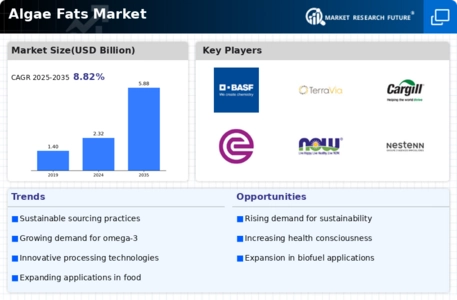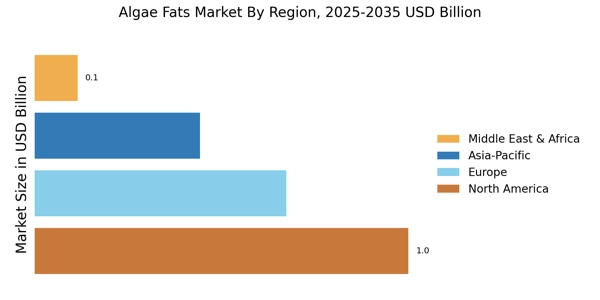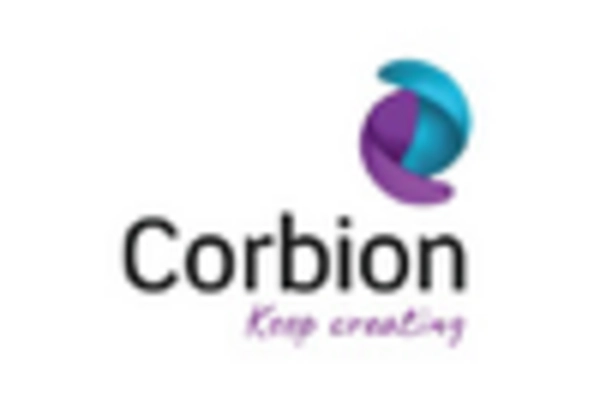Innovations in Food Technology
Innovations in food technology are playing a pivotal role in shaping the Algae Fats Market. Advances in processing techniques and formulation strategies are enabling manufacturers to create high-quality algae fats that meet consumer preferences. For instance, the development of microencapsulation technology allows for the stabilization of sensitive nutrients, enhancing the shelf life and usability of algae fats in various food applications. Additionally, the incorporation of algae fats into functional foods and dietary supplements is gaining traction, as these products align with the growing trend of health-oriented consumer choices. Market data suggests that the functional food sector is expanding rapidly, providing a fertile ground for the Algae Fats Market to thrive. As food technology continues to evolve, the potential for innovative algae fat applications appears promising.
Increasing Health Consciousness
The Algae Fats Market is experiencing a surge in demand driven by rising health consciousness among consumers. As individuals become more aware of the health benefits associated with omega-3 fatty acids, which are abundant in algae fats, the market is likely to expand. Research indicates that omega-3 fatty acids can contribute to heart health, cognitive function, and overall well-being. This growing awareness is prompting food manufacturers to incorporate algae fats into their products, thereby enhancing nutritional profiles. Furthermore, the global market for omega-3 fatty acids is projected to reach substantial figures, indicating a robust opportunity for the Algae Fats Market to capitalize on this trend. As consumers increasingly seek healthier alternatives to traditional fats, the demand for algae-derived products is expected to rise significantly.
Expansion of Vegan and Vegetarian Diets
The expansion of vegan and vegetarian diets is a notable driver for the Algae Fats Market. As more individuals adopt plant-based lifestyles, the demand for alternative sources of fats and oils is increasing. Algae fats, being plant-derived, offer a viable solution for those seeking to eliminate animal products from their diets while still obtaining essential fatty acids. Market data suggests that the plant-based food sector is experiencing rapid growth, with projections indicating a substantial increase in market size over the coming years. This trend presents a significant opportunity for the Algae Fats Market to cater to the evolving dietary preferences of consumers. As the popularity of vegan and vegetarian diets continues to rise, the incorporation of algae fats into various food products is likely to become more prevalent.
Rising Interest in Sustainable Ingredients
The Algae Fats Market is benefiting from a rising interest in sustainable ingredients among consumers and manufacturers alike. Algae cultivation is often regarded as an environmentally friendly alternative to traditional agricultural practices, as it requires fewer resources such as land and water. This sustainability aspect resonates with eco-conscious consumers who are increasingly seeking products that align with their values. Furthermore, the global push towards reducing carbon footprints and promoting sustainable sourcing is likely to bolster the demand for algae fats. Market analysis indicates that the sustainable food market is projected to grow significantly, providing a favorable environment for the Algae Fats Market to flourish. As more companies commit to sustainability goals, the integration of algae fats into their product lines may become a strategic priority.
Regulatory Support for Alternative Proteins
Regulatory support for alternative proteins is emerging as a key driver for the Algae Fats Market. Governments and regulatory bodies are increasingly recognizing the importance of diversifying protein sources to enhance food security and sustainability. This recognition is leading to favorable policies and funding initiatives aimed at promoting the development of alternative protein sources, including algae. As regulations evolve to support the use of algae in food products, the Algae Fats Market stands to benefit from increased legitimacy and market access. Furthermore, the global trend towards reducing reliance on animal agriculture aligns with regulatory efforts to encourage sustainable practices. Industry expert's suggest that the alternative protein sector is poised for growth, creating a conducive environment for the Algae Fats Market to thrive.


















Leave a Comment